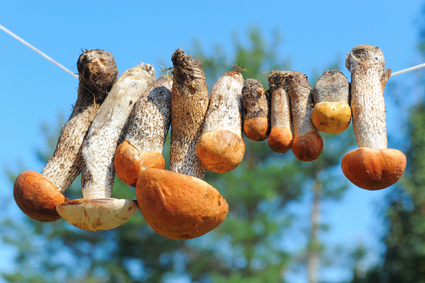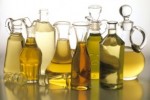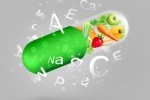Our ancestors used to collect mushrooms in the fall and dry them out in the sun to preserve for winter. Is it only a coincidence that mushrooms that were exposed to UV radiation are found to have a good amount of vitamin D or is it our ancestors instinctively knew that? Today vitamin D deficiency is pandemic. It is believed that majority of the industrialized diseases are, at least, partially associated with vitamin D deficiency. The most historically known vitamin D deficiency is Rickets. During late 18th early 19th century, Rickets spread out through Europe and the United States through the most industrialized cities. The Netherlands in 19th century found 80-90% of the children to suffer from Rickets. But rickets is the end of the spectrum of the vitamin D deficiency; there are many other health consequences somewhere in between the spectrum of vitamin D deficiency.
Land vertebrates, including humans required vitamin D to maintain adequate serum Calcium and bone metabolism. Sun light /or UV light has been known for years to naturally increase vitamin D in the blood and this way to cure Rickets. Scientists claim that mushrooms can be as effective as sun or supplements to provide us with vitamin D. You may wonder why mushrooms. Very few foods naturally have considerable amounts vitamin D (about 1000-2000IU/serving), those on the top of the list are: the famous Rickets’ treatment (cod liver), fish oil, herring and salmon. There are some other fish that have some vitamin D but it occurs in much lesser amounts. So, what’s similarity between fish and mushrooms, and why mushrooms contain the highest amount of vitamin D of all plants on the land?
It is theorized that 900 million years ago primitive life forms were bombarded by the sun’s UV radiation, between 240-320nm, damaging their DNA and RNA. Thus, the sunscreen – provitamin D2 may have played an important role in survival of those organisms. Phytoplankton and zooplankton that produced vitamin D2 were likely to protect their DNA and RNA from UV radiation and were able to pass their genes to their offspring. It explains why fish fed phytoplankton at the bottom of the ocean have the highest amounts of vitamin D. Fungi- like phytoplankton produce large amounts of vitamin D2 when exposed to UV radiation. This explains why mushrooms are good candidate to have a high capacity to produce vitamin D.
Mushrooms are known to contain provitamin D2 which can be converted to previtamin D2 when exposed to UV radiation. Previtamin D2 in mushrooms can rapidly be converted to vitamin D2. But so far, science has been debating whether vitamin D2 increases or decreases 25 (OH)D blood concentration. Stephenson et al. found in their study that ingesting UVB radiated mushrooms containing vitamin D2 resulted in a small decrease in total 25(OH) D levels. Thus to investigate this question, Department of Medicine: Vitamin D, Skin and Bone Research Laboratory conducted their own study. They also reevaluated the statement that vitamin D2 is the only source of vitamin D in the mushrooms. The research team revealed that only 5 minutes of exposure to UV radiation was required for conversion provitamin D2 to previtamin D2. But according to previous study cited in this literature, it is a time dependent process to convert previtamin D2 to vitamin D2, and there was only 24% of vitamin D converted after 6h radiation, compared to 50% after 11.5 hours in white button mushrooms. On the other hand, scientists mention that the amount of converted vitamin D2 depends on the type of mushroom as well, for example 19% of vitamin D2 has been found in ampoules after 11.5hours radiation. So, another words if you want to receive vitamin D2 from your white button mushrooms, you may want to lay them out in sunshine (or other UV light) and the exposure should take about 12hours for conversion of only half of previtamin D2 to vitamin D2. But if you have a different type of mushroom, the time of the process may be different.
In this study, Keegan et al. examined crimni, oyster, portabella, shiitake, white button mushrooms, white button mushroom power and S. cereviscae yeast for the presence of provitamin D2, vitamin D2, provitamin D4, vitamin D4 and other potential vitamin Ds. As the research team hypothesized, there were different amounts of vitamin D2 and vitamin D4 in different mushrooms. It is known that vitamin D4 is 60 % as effective as vitamin D3. The study showed white button mushroom powder contained 88% vitamin D2 and 12% vitamin D4, whereas S. cereviscae yeast sample contained 99% vitamin D2 and 1% vitamin D4. Vitamin D3 was identified in several mushrooms as well, such as shiitake mushrooms.
Keegan et al. also investigated the question of efficacy of vitamin D2 from white button mushroom compare to supplemental vitamin D3. Thirty participants were randomly divided into 3 groups: 1st group ingested capsule 2000 IU vitamin D2, 2nd-2000 IU vitamin D3, and 3d group ingested 2000 IU mushroom vitamin D2 once a day for 3 months during the winter. The Vitamin Ds concentrations were measured once a week for 12 weeks. “At the end of 12 weeks, serum total 25 (OH)D levels were not statistically significantly different in all three groups: 34.4ng/ml, 29.2ng/ml and 30.1ng/ml for supplemental vitamin D3, D2, and mushroom D2 respectively.” Which demonstrates that mushroom containing D2 was as effective to maintain 25(OH) D levels as supplement vitamin D2 and vitamin D3. So while the summer’s sun can provide us up to 10,000IU within 15-30 min, mushrooms can provide us up to 4,000IU/serving during the winter. Just remember to expose your mushrooms gills up to UV light for at least 12 hours.








I love finding out about the benefits of mushrooms. I knew that some were amazing for the brain, but it’s also nice to know that they are such a good source of vitamin D. I was diagnosed with a vitamin D deficiency. It was causing me to gain weight regardless of a healthy diet and exercise regiment and it was also causing me to faint because it wasn’t interacting with the calcium in my body. I think I’ll have to try the mushrooms listed at the end of this article. Thanks for the post!
[...] Even though the study did not have the highest level design, Bose at el. showed a definite association between vitamin D levels and allergy marker-IgE. Obviously vitamin D deficiency is not the only missing element that induces allergies and asthma, but it is already known that vitamin D deficiency is an initiator for several industrialized disorders, including asthma. It is also easy to see that deprivation of vitamin D after winter may cause more severe symptoms of allergy in the spring time. Vitamin D deficiency is growing at the same speed as obesity, diabetes and allergies in this country. Several studies showed supplementation of vitamin D can easily increase vitamin D concentration in the blood, as do mushrooms (read article for more information on this topic). [...]
[...] Cereals have around 50- 200 IU (fortified). Mushrooms can have from 160-4000 IU per serving (read more about mushrooms and vitamin D). One large egg contains around 25- 50 IU. Swiss cheese has only 6 IU per [...]
[...] As was noted earlier, many fatty fish contain daily doses or more of vitamin D. But there are also other foods that could help you to increase vitamin D intake. Some vitamin D can be lost during cooking. To learn how much vitamin D is lost during different ways of cooking read “Is Vitamin D lost during cooking?” Additionally, mushrooms can produce large amounts of vitamin D, read more about it “Sunshine or Mushrooms for Vitamin D?” [...]